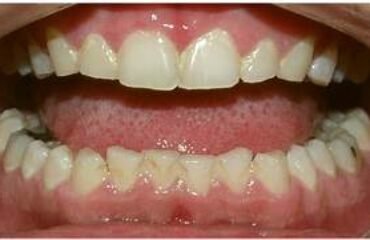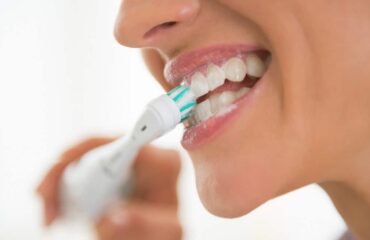 “HEALTHY GUMS = HEALTHY MOUTH”Gum health, also known as periodontal health, is a critical aspect of overall oral health. It refers to the condition of the tissues that surround and support your teeth, including the gums (gingiva), the bone that holds the teeth in place, and the periodontal ligaments that connect the teeth to the bone. GOOD GUM HEALTH IS CHARACTERIZED BY:
“HEALTHY GUMS = HEALTHY MOUTH”Gum health, also known as periodontal health, is a critical aspect of overall oral health. It refers to the condition of the tissues that surround and support your teeth, including the gums (gingiva), the bone that holds the teeth in place, and the periodontal ligaments that connect the teeth to the bone. GOOD GUM HEALTH IS CHARACTERIZED BY: - Pink and firm gums: Healthy gums are typically pink or coral in color and have a firm texture. They should not bleed when you brush or floss your teeth.
- Minimal or no pain or discomfort: Healthy gums should not cause pain or discomfort during eating, drinking, or oral hygiene routines.
- Tight attachment: The gum tissue should fit snugly around the teeth, creating a protective seal.
- Gingivitis: Gingivitis is the earliest stage of gum disease and is characterized by inflamed, red, and bleeding gums. It is usually caused by poor oral hygiene, leading to the accumulation of plaque, a sticky film of bacteria on the teeth and gums.
- Periodontitis: If gingivitis is left untreated, it can progress to periodontitis. This is a more severe form of gum disease where the inflammation extends deeper into the supporting structures of the teeth, including the bone. Symptoms may include gum recession, tooth mobility, and even tooth loss.
- Bad Breath (Halitosis): Gum problems can contribute to chronic bad breath, also known as halitosis, due to the presence of bacteria in the mouth.
- Tooth Sensitivity: Gum recession can expose the sensitive root surfaces of teeth, leading to increased tooth sensitivity to hot, cold, sweet, or acidic foods and drinks.
- Systemic Health Issues: Some research has suggested that there may be a link between gum disease and other systemic health issues such as heart disease, diabetes, and respiratory diseases. While the exact nature of these connections is still being studied, maintaining good gum health is considered important for overall health.
- Oral Hygiene Practices: Proper brushing and flossing are essential for preventing gum disease. Inadequate or inconsistent oral hygiene can lead to the buildup of plaque, a bacterial film on teeth and gums, which can cause gum inflammation and disease.
- Tobacco Use: Smoking or using smokeless tobacco products significantly increases the risk of gum disease. Tobacco use reduces blood flow to the gums, impairs the immune system’s ability to fight infection, and hinders the healing process.
- Diet: A diet high in sugary foods and drinks can promote the growth of harmful bacteria in the mouth, leading to gum disease and tooth decay. A balanced diet rich in fruits, vegetables, and whole grains can support gum health.
- Alcohol Consumption: Excessive alcohol consumption can dry out the mouth and reduce saliva production, which is essential for maintaining oral health. A dry mouth can increase the risk of gum disease and tooth decay.
- Genetics: Some individuals may be genetically predisposed to gum disease. If your family has a history of gum problems, you may be at a higher risk and should be especially vigilant about oral hygiene and regular dental check-ups.
- Hormonal Changes: Hormonal fluctuations, such as those during puberty, pregnancy, menstruation, and menopause, can affect gum health. Hormonal changes can make the gums more susceptible to inflammation and gingivitis.
- Medical Conditions: Certain medical conditions, such as diabetes and autoimmune diseases, can increase the risk of gum disease. Medications used to manage these conditions may also have side effects that affect oral health.
- Stress: Chronic stress can weaken the immune system and increase the body’s susceptibility to infection, including gum infections. Stress can also lead to teeth grinding (bruxism), which can damage the gums.
- Age: As individuals age, they may become more susceptible to gum problems. Gum recession, decreased saliva production, and other age-related changes can impact gum health.
- Poorly Fitted Dental Appliances: Ill-fitting dentures, braces, or dental appliances can irritate the gums and lead to gum problems if not adjusted or maintained properly.
- Substance Abuse: Illicit drug use, particularly substances like methamphetamine, can have severe oral health consequences, including severe gum disease known as “meth mouth.”
- Lifestyle Habits: Habits like nail-biting or using teeth to open objects can injure the gums and lead to gum problems.
- Oral Hygiene: Follow a strict oral hygiene routine, including brushing your teeth at least twice a day and flossing daily. Use a soft-bristle toothbrush and fluoride toothpaste.
- Proper Brushing Technique: Use gentle, circular motions when brushing your teeth, and be thorough in reaching all areas of your mouth, including the gumline.
- Flossing: Floss daily to remove plaque and food particles from between your teeth and along the gumline.
- Mouthwash: Use an antimicrobial or fluoride mouthwash to help control bacteria and strengthen teeth.
- Regular Dental Check-ups: Visit your dentist for regular check-ups and professional cleanings. This allows for the early detection of gum problems and prompt treatment.
- Lifestyle Changes: Quit smoking or using tobacco products, as they are major contributors to gum disease.
- Dietary Choices: Consume a balanced diet rich in fruits, vegetables, whole grains, and lean proteins. Limit sugary and acidic foods and beverages, which can contribute to gum problems.
- Hydration: Stay well-hydrated to support saliva production, which helps cleanse the mouth of harmful bacteria.
- Stress Management: Find healthy ways to manage stress, as chronic stress can negatively impact gum health.
- Protect Teeth: Avoid using teeth as tools for opening packages or biting on hard objects.
- Dental Cleanings: Professional dental cleanings (dental prophylaxis) remove plaque and tartar buildup, which can contribute to gum disease. The frequency of cleanings will depend on your individual needs and risk factors.
- Scaling and Root Planning: For individuals with gum disease, a deep cleaning procedure called scaling and root planning may be necessary. It involves removing plaque and tartar from below the gumline and smoothing the tooth roots to promote gum reattachment.
- Pocket Reduction Surgery: In advanced cases of gum disease, where pockets have formed between the gums and teeth, surgical procedures may be required to reduce pocket depths and improve gum attachment.
- Gum Grafting: Gum grafting can treat gum recession by taking tissue from one part of the mouth (often the palate) and grafting it onto the affected area.
- Antibiotics: In some cases, your dentist or periodontist may prescribe antibiotics to control bacterial infections associated with gum disease.
- Laser Therapy: Laser treatment can be used to remove infected tissue and promote healing in gum disease cases.
- Orthodontic Treatment: In cases where misaligned teeth contribute to gum problems, orthodontic treatment may be recommended to correct the bite.
- Dental Appliances: Ill-fitting dental appliances, such as dentures or braces, may need adjustments or replacements to reduce irritation to the gums.
- Gingival Overgrowth: Flap surgery may be recommended when the gum tissue has overgrown and covers too much of the tooth surface, often due to factors like medications or certain medical conditions.
- Gum Recession: In cases of gum recession, where the gum tissue has pulled away from the teeth, exposing the tooth’s root surface, flap surgery can be used to reposition and cover the exposed root.
- Gum Pocket Reduction: When deep pockets have formed between the gums and teeth due to periodontal disease (periodontitis), flap surgery can be performed to access and clean the roots of the teeth, remove diseased tissue, and reduce pocket depths.




